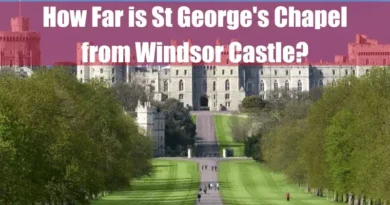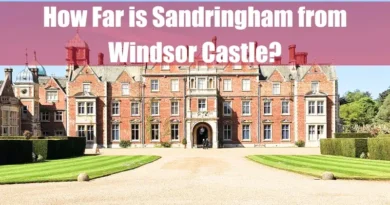What Is Special About Windsor Castle
Windsor Castle, located in Berkshire, England, is notable for being the world’s oldest and largest inhabited castle, serving as a royal residence for over 900 years. Built in the 11th Century by William the Conqueror, it has continuously housed British monarchs, making it Europe’s longest-occupied palace. The castle encompasses significant architectural and historical features, including the State Apartments, renowned for their lavish Georgian design, and St George’s Chapel, an exemplary piece of English Perpendicular Gothic architecture. Today, Windsor Castle remains a functional royal home, hosting state events and attracting numerous visitors annually.
Takeaways
| Key Points |
|---|
| Windsor Castle’s architectural layout is divided into three primary wards: the Upper Ward, which houses the grand State Apartments and royal residences; the Middle Ward, dominated by the Round Tower, a historical defensive and residential structure; and the Lower Ward, home to the Gothic masterpiece St George’s Chapel and the residences of the Military Knights of Windsor. |
| The Round Tower, originally built in the 12th century and raised in height in the 19th century, played a crucial defensive role due to its elevated position on a 50-foot artificial mound and now houses the Royal Archives and the Royal Photograph Collection. |
| Over the centuries, Windsor Castle has evolved architecturally, from its medieval motte-and-bailey origins under William the Conqueror to the Georgian and Victorian enhancements by King George IV, culminating in modern restorations following the 1992 fire. |
| St George’s Chapel, a prime example of Perpendicular Gothic architecture, serves as the spiritual home of the Order of the Garter and has hosted numerous royal weddings and burials, while the lavish State Apartments contain a wealth of artistic treasures, including the Waterloo Chamber and Crimson Drawing Room. |
| The castle remains an official royal residence, hosting state ceremonies and functions, and is set within extensive gardens, including the Home Park, Windsor Great Park, and the historic Long Walk, all contributing to its grandeur and historical significance. |
Introduction
Windsor Castle, located in Berkshire, England, stands as a monumental testament to British history and architecture. As the world’s oldest and largest inhabited castle, it has been a royal residence for over nine centuries. Its continuous evolution reflects the dynamic narrative of the British monarchy and the nation’s architectural advancements.
Historical Significance
Origins and Construction by William the Conqueror in the 11th Century
The origins of Windsor Castle can be traced back to the aftermath of the Norman Conquest. Around 1070, William the Conqueror initiated the construction of a series of fortifications to establish Norman dominance over England. Windsor Castle was among these early defences, strategically positioned overlooking the River Thames. Initially built as a motte-and-bailey structure using timber, its primary purpose was to guard the western approaches to London and assert control over the surrounding area. This location not only offered strategic military advantages but also provided proximity to vital transport routes and hunting grounds.
Role Throughout British History, Including Events and Transformations
Throughout its extensive history, Windsor Castle has been at the epicentre of numerous pivotal events and transformations:
- Medieval Era: King Henry I, in the early 12th Century, began using Windsor Castle as a royal residence, marking the start of its continuous association with the monarchy. King Edward III, born at Windsor, initiated an ambitious reconstruction in the 14th Century, transforming it into a symbol of royal splendour and the administrative heart of the Order of the Garter, established in 1348.
- Tudor and Stuart Periods: The castle witnessed significant events, including hosting grand state occasions under Henry VIII and serving as a refuge for Queen Elizabeth I during times of plague. During the English Civil War in the 17th Century, it was utilised as a military headquarters by Parliamentary forces and even housed prisoners, including King Charles I, before his execution.
- Georgian and Victorian Eras: The 18th and 19th centuries saw extensive renovations. King George IV commissioned architect Jeffry Wyatville to modernise the castle, leading to the creation of the grand State Apartments. Queen Victoria further embraced Windsor as a royal retreat, making it a centre for court life and state affairs.
- Modern Day: In the 20th and 21st centuries, Windsor Castle has continued to serve as a royal residence, hosting state visits and ceremonies. Notably, it was a sanctuary for the royal family during World War II and, more recently, served as a residence for Queen Elizabeth II during the COVID-19 pandemic. The castle remains a symbol of resilience, adapting through centuries while preserving its historical essence.
Architectural Features

Description of the Castle’s Layout: Upper Ward, Middle Ward, and Lower Ward
Windsor Castle’s architectural layout is a harmonious blend of functionality and grandeur, divided into three primary sections:
- Upper Ward: This area serves as the castle’s heart, encompassing the principal royal apartments and the State Apartments. Arranged around the Quadrangle, the Upper Ward showcases the castle’s most opulent interiors and offers expansive views of the surrounding landscape.
- Middle Ward: Dominated by the iconic Round Tower, the Middle Ward sits atop a man-made motte and forms the central part of the castle. It acts as a pivotal junction between the Upper and Lower Wards, with the Round Tower historically serving both defensive and residential purposes.
- Lower Ward: Located to the west of the Round Tower, the Lower Ward is home to St George’s Chapel, a masterpiece of Gothic architecture. This ward also includes the Military Knights of Windsor residences and other associated buildings, forming a community centred around the chapel’s religious activities.

Details of the Round Tower and Its Strategic Importance
The Round Tower stands as a central feature of Windsor Castle, rich in history and significance:
- Historical Development: Constructed in the 12th Century, the Round Tower was initially designed as a defensive stronghold. In the early 19th Century, architect Jeffry Wyatville elevated the tower by an additional 30 feet to enhance its imposing presence. This modification not only augmented its defensive capabilities but also contributed to the castle’s iconic silhouette.
- Strategic Role: Perched atop a 50-foot artificial mound, the Round Tower’s elevated position provided a vantage point for surveillance and defence, overseeing the River Thames and the surrounding territories. Its central location within the castle complex made it a linchpin in the overall defensive strategy, controlling access between the Upper and Lower Wards.
- Modern Use: The Round Tower houses the Royal Archives and the Royal Photograph Collection today, preserving centuries of royal documents and images. While its defensive role has diminished, the tower symbolises the monarchy’s enduring legacy and the castle’s historical significance.

Evolution of Architectural Styles Over the Centuries
Windsor Castle’s architecture reflects a rich tapestry of styles, mirroring the tastes and requirements of successive monarchs:
- Medieval Foundations: Established in the 11th Century by William the Conqueror, the original structure was a motte-and-bailey design constructed from timber. Over time, this was replaced with stone fortifications, laying the groundwork for the castle’s enduring presence.
- Georgian and Victorian Enhancements: The 18th and 19th centuries introduced significant modifications. King George IV began extensive renovations, infusing the castle with Georgian and Victorian design elements. These enhancements included the addition of Gothic features reimagined in a modern style, contributing to the castle’s unique architectural blend.
- Modern Restorations: In the late 20th Century, particularly following a fire in 1992, meticulous restoration efforts were undertaken. These aimed to preserve the castle’s historical essence while incorporating contemporary amenities, ensuring its continued relevance and functionality.

This architectural evolution has transformed Windsor Castle from a medieval fortress into a symbol of British heritage, seamlessly blending historical authenticity with modern adaptations.
St George’s Chapel

Architectural Design and Significance
St George’s Chapel, located within the Lower Ward of Windsor Castle, is a prime example of Perpendicular Gothic architecture. Founded in the 14th Century by King Edward III, the chapel was extensively enlarged in the late 15th Century. Its design features large windows with vertical tracery and elegant stone detailing, characteristic of the English Perpendicular Gothic style. The chapel serves as a Royal Peculiar, meaning it is under the direct jurisdiction of the monarch and has been the site of numerous royal ceremonies, weddings, and burials.
Association with the Order of the Garter
Established by King Edward III in 1348, the Order of the Garter is Britain’s oldest and most senior Order of Chivalry. St George’s Chapel serves as the spiritual home of this prestigious order. Each year, a procession and service are held within the chapel to celebrate the order, with the Sovereign and Knights donning elaborate robes and insignia. The stalls (seats) of the chapel are adorned with the heraldic banners of the Knights, symbolising their membership.
Notable Ceremonies and Royal Events
St George’s Chapel has been the venue for numerous significant royal events. It has hosted royal weddings, including those of Prince Harry and Meghan Markle in 2018. The chapel is also the final resting place for several monarchs, such as King Henry VIII and Queen Elizabeth II. Its rich history and architectural grandeur make it a focal point for royal ceremonies and a symbol of enduring tradition.

State Apartments

Overview and Ceremonial Use
The State Apartments at Windsor Castle are a series of grand rooms used for official and state occasions. Situated in the Upper Ward, these apartments showcase a range of architectural styles and house an extensive collection of art and furnishings. They serve as the setting for ceremonial events, and official entertaining and are open to the public when not in use by the Royal Family.
Highlights of Specific Rooms
- Waterloo Chamber: This impressive room was created to commemorate the victory over Napoleon at the Battle of Waterloo in 1815. It features portraits of the monarchs, statesmen, and military leaders allied against Napoleon, painted by Sir Thomas Lawrence. The chamber is used for large gatherings and state banquets.
- Crimson Drawing Room: Part of the Semi-State Rooms, the Crimson Drawing Room is adorned with rich red upholstery and gold accents. It offers spectacular views across the Berkshire countryside and is used by the Royal Family for private events. The room was meticulously restored after the fire of 1992 to reflect its original splendour.

Artistic and Decorative Treasures
The State Apartments house an extensive collection of artistic and decorative treasures. Visitors can admire works by renowned artists, intricate tapestries, and exquisite furniture. The rooms themselves are adorned with ornate ceilings, gilded mouldings, and other architectural details that reflect the British monarchy’s rich history and artistic heritage.

Queen Mary’s Dolls’ House
History and Creation
Queen Mary’s Dolls’ House is the world’s largest and most famous dolls’ house. Built between 1921 and 1924 for Queen Mary, consort of King George V, it was designed by the leading British architect Sir Edwin Lutyens. The house was intended to showcase the finest British craftsmanship and includes contributions from over 1,500 artists, craftsmen, and manufacturers.

Unique Features
This remarkable miniature residence is equipped with functional utilities, including running water, electricity, and working lifts. It boasts a fully stocked library with original works by prominent authors, a wine cellar filled with miniature bottles, and a garage complete with tiny automobiles. The attention to detail extends to miniature artworks, bespoke furniture, and even tiny household items, reflecting the grandeur of an aristocratic home.
Recent Additions and Commemorations
In 2024, the room housing this miniature marvel was re-presented to mark the centenary of Queen Mary’s Dolls’ House. Designed by Sir Edwin Lutyens, the space features murals by artists Philip Connard, Dorothy Cohen, and Winifred Hardman. Additionally, for the first time, the dolls’ house was adorned with miniature Christmas decorations, including tiny glass bead baubles and candles, adding a festive touch to this historic artefact.
These elements of Windsor Castle—the historic St George’s Chapel, the opulent State Apartments, and the intricate Queen Mary’s Dolls’ House—each contribute to the castle’s unique charm and significance, offering visitors a glimpse into the rich tapestry of British royal history and culture.
Royal Residence and Functions
Current Role as an Official Residence of the British Monarch
Windsor Castle stands as one of the principal residences of the British monarch, embodying a rich tapestry of royal heritage and tradition. Serving as a royal home for over nine centuries, it continues to function as a working palace where the Sovereign frequently resides. The castle’s enduring role underscores its significance in the daily and ceremonial life of the monarchy.

Use for State Events, Ceremonies, and Royal Gatherings
Beyond its residential purpose, Windsor Castle is a pivotal venue for state events and official ceremonies. The grandeur of its State Apartments provides a fitting backdrop for hosting visiting dignitaries and conducting investitures. Notably, with the ongoing refurbishment of Buckingham Palace, Windsor Castle has assumed an even more prominent role, accommodating state visits and significant royal functions during this period.
Departments of the Royal Household Based at Windsor Castle
The castle also serves as a hub for various departments of the Royal Household. The historic Round Tower houses the Royal Archives and the Royal Photograph Collection, preserving invaluable records and visual documentation of the monarchy’s history. Additionally, the Print Room and Royal Library within the castle safeguard precious drawings, prints, manuscripts, and books, reflecting the cultural and artistic patronage of the Royal Family.
Gardens and Grounds

Description of the Home Park and Windsor Great Park
Encompassing the castle are expansive green spaces that enhance its picturesque setting. The Home Park, directly adjoining the castle, spans approximately 265 hectares and includes parkland, gardens, and two working farms. Beyond this lies Windsor Great Park, covering about 2,020 hectares. This ancient royal landscape features a diverse mix of forests, grasslands, lakes, and formal gardens, offering habitats for a variety of wildlife and serving as a recreational area for the public.

The Long Walk and Its Historical Significance
A striking feature of Windsor Great Park is the Long Walk, a tree-lined avenue extending nearly 2.5 miles from the castle’s gates to the Copper Horse statue. Established by King Charles II in the late 17th Century, the Long Walk was designed to create a grand approach to the castle. Today, it remains a popular route for both ceremonial processions and leisurely walks, offering iconic views of the castle framed by a canopy of trees.

Notable Features Within the Grounds, Such as the Curfew Tower
Within the castle’s precincts stands the Curfew Tower, one of the oldest surviving structures dating back to the 13th Century. Historically serving as part of the castle’s defensive system, the tower has also functioned as a prison and houses a bell that once signalled the curfew. Its enduring presence adds to the rich architectural tapestry and historical depth of Windsor Castle.
Cultural and Tourist Attractions
Public Access and Tours Available to Visitors
Windsor Castle welcomes visitors year-round, offering a glimpse into its storied past and royal splendour. Guests can explore the State Apartments, Queen Mary’s Dolls’ House, and St George’s Chapel, each showcasing unique aspects of the castle’s heritage. Guided tours provide in-depth insights, while multimedia guides are available in multiple languages to enhance the visitor experience.
Annual Events and Exhibitions Hosted at the Castle
The castle hosts various events and exhibitions throughout the year, celebrating its history and contemporary significance. These include special displays of royal artefacts, art exhibitions, and the annual Garter Day procession, honouring the Order of the Garter. Seasonal events, such as festive decorations during Christmas, add to the castle’s appeal, drawing visitors from around the world.
Impact on Local Tourism and the Surrounding Community
As a major landmark, Windsor Castle significantly contributes to local tourism, attracting millions of visitors annually. This influx supports local businesses, including hotels, restaurants, and shops, bolstering the economy of Windsor and its environs. The castle’s presence fosters a sense of community pride and serves as a cultural hub, hosting events that engage both residents and visitors.
Conclusion
Windsor Castle stands as a symbol of enduring royal heritage, architectural grandeur, and historical significance. From its role as a royal residence and venue for state occasions to its inviting gardens and cultural attractions, the castle seamlessly blends tradition with contemporary relevance. Its impact extends beyond its walls, enriching the local community and captivating the imaginations of those who visit from near and far.









